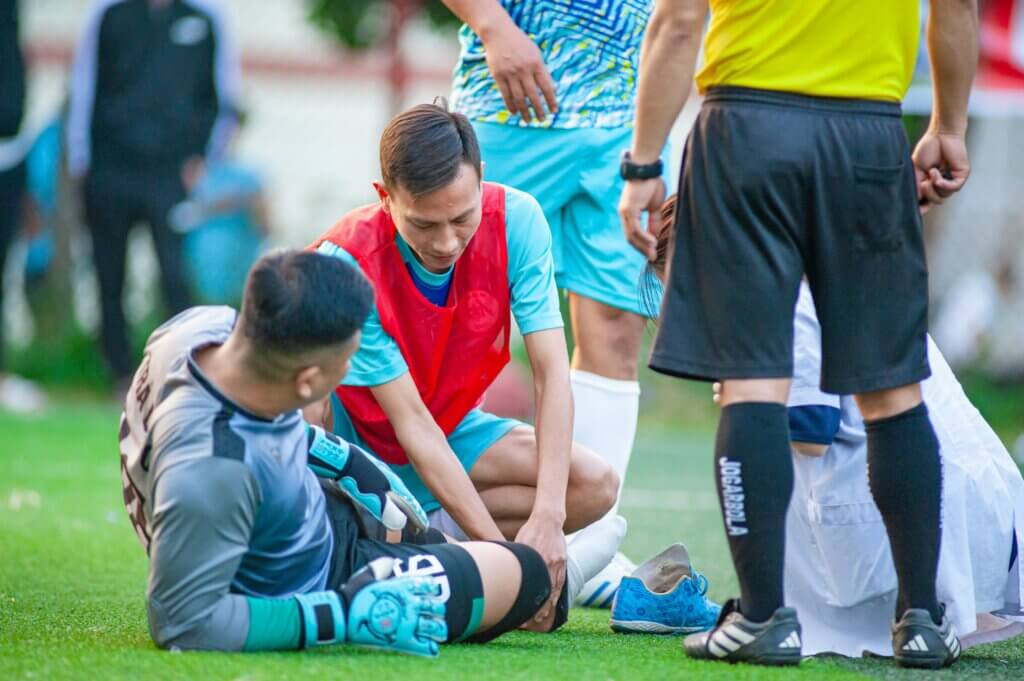With the 2022 FIFA World Cup getting underway in Doha Qatar, it presents an opportune time to investigate the injury incidences and rates in elite football (soccer) players to provide an overview of the types of injuries players may succumb to during the tournament. As a leading sports chiropractic clinic the Shannon Clinic – Melbourne Chiropractic and Sports Care has experience reviewing injuries rates in elite sports, in addition to a wealth of experience working with athletes across a wide variety of sports including elite soccer, postitioning us well for this review.
To start with let’s clarify the different terms used to monitor injuries. The two measures are injury rate and injury incidence. These might sound very similar but they measure different aspects of an injury. Injury rates are fairly simple, such as the number of ankle injuries that occurred divided by an exposure time, such as the number of hours played. Injury incidence, measures the risk of sustaining say an ankle injury. In football 1000 hours played either match or training are routinely used exposure time frames.
Now we understand the difference between injury rate and incidence, here are findings from 3 studies looking at injury incidences and rates in elite soccer players.
UEFA Injury Rates
Over 18 years, the study saw a 3% per season reduction in injuries during training and matches, this in part is likely to be a reflection on the success of injury prevention programs including the FIFA 11+ program.

- 8.0 injuries per 1000 hours – (injury incidence)
- 27.5 injuries per 1000 hours of match play – (injury incidence)
- 4.1 injuries per 1000 hours of training play – (injury incidence)
- 87% of injuries involved the lower extremity
- 57% of all injuries were muscle and ligament injuries
- Thigh, knee, hip/groin, ankle were the most common locations
- Thigh strains were the single most common injury – 17% of all injuries (hamstring > quad)
- Adductor strains – 9%, Ankle sprains 7%, MCL injuries 5% of all injuries
- 81% of injuries occurred due to trauma during matches
- 12% of all injuries were reinjuries
- 2% of all injuries were head related
Spanish First Division Injury Rates
A 5 season prospective study (forward looking study) involving a first division Spanish league club found the following.
- 88% of all injuries involved the lower limb
- 29% involved the thigh (hamstring/quad)
- 20% involved the groin (adductor strains/pubalgia)
- 13% involved the ankle (sprains, high ankle sprain)
- 11% involved the knee (ligament, ACL, meniscus)
- Overuse injuries were > traumatic
- Non-contact were > contact
- No difference between injuries sustained during matches or training
- Women experience 5 times more ACL injuries than men
- 2% of all injuries were head related
Systematic Review of Injuries in Male Professional Soccer Players
A 2016 systematic review which included 8 prospective studies with a minimum study period of 6 months found the following.
- 2.48 – 9.4 injuries per 1000 hours of exposure time
- 8.7 – 65.9 injuries per 1000 hours of match play
- 1.37 – 5.8 injuries per 1000 hours of training play
- Thigh was the most common injury site (hamstring > quad)
- Higher incidence of hamstring over quadriceps strains
- Other common injury locations, knee, groin, ankle
- Low rate of fractures
- 15% of injuries were reinjuries
- 63% of injuries were overuse
- Players with a prior injury were at a 4 to 7 times greater risk of a subsequent injury
- Reinjury incidences of 9 to 30% which resulted in longer time out than a new injury
- Reinjury rates more frequently occurred at training and were associated with overuse
What Does All This Injury Data Mean?

Across these three studies there are clear injury trends in football. More injuries occur in matches than training. Nearly 90% of all injuries in football occur in the lower limb. There is a caveat that needs to be added here, 2 studies reported only 2% of injuries occurred to the head. Knowing head to head contact in football is prevalent, it could indicate concussion is being underreported. This is further supported, by a study examining injuries in the 2014 World Cup, where injuries to the head were the second highest injury site at 18% behind thigh injuries; yet out of the 19 injuries to the head, only 5 were reported as concussion even though 18 involved contact to the head. Thigh strains are consistently the most common injury site, with a greater, incidence of hamstring over quadriceps strains. The groin, knee and ankle are the next most common injury sites after the thigh. Although there is mixed data on traumatic onset versus overuse for injuries, there is enough data to suggest training/playing loads are likely to conrtibute to football injuries. Finally, there are reasonably high reinjury rates which is not surprising considering the high rates of muscle strain and ligament injuries, indicating players are potentially returning to the field too earlier which is supported by evidence showing muscle imbalances and altered landing mechanics exist in football players returning early from ACL reconstruction surgery.
In summary, at this years World Cup we are likely to see hamstring, quadriceps, adductor strains, ankle and knee (ACL, MCL) ligament injuries, as well as concussion during match play. If any player is coming in either with a recent injury, or a history of injuries (especially soft tissue) they do so with a higher incidence of reinjury. No-one likes seeing players get injured, especially at tournaments like the World Cup which only occur every 4 years. However, injury rates at the 2014 World Cup reduced by 37% over a 12 year period from 2002, and we hope this trend continues in Qatar.
To read more about injuries in soccer click here and if you have a soccer based injury be sure to make an appointment to be assessed by Melbourne sports chiropractor Dr. Nicholas Shannon at the Shannon Clinic – Melbourne Chiropractic and Sports Care, centrally located on Collins Street, in the heart of Melbourne’s CBD.
